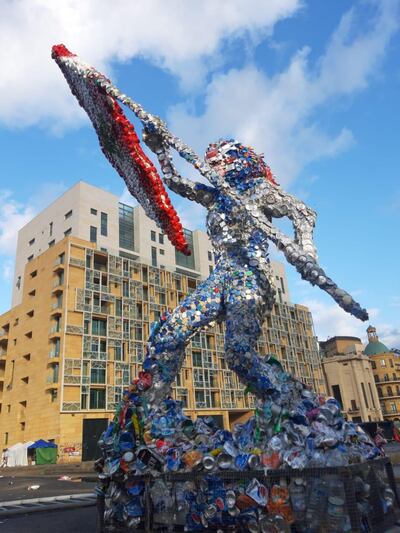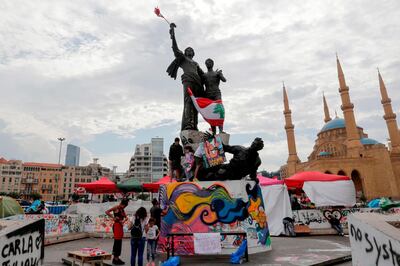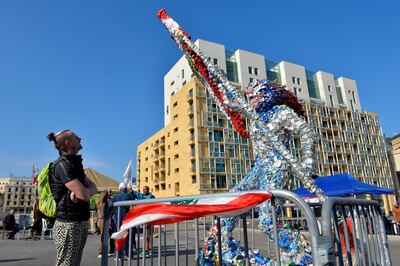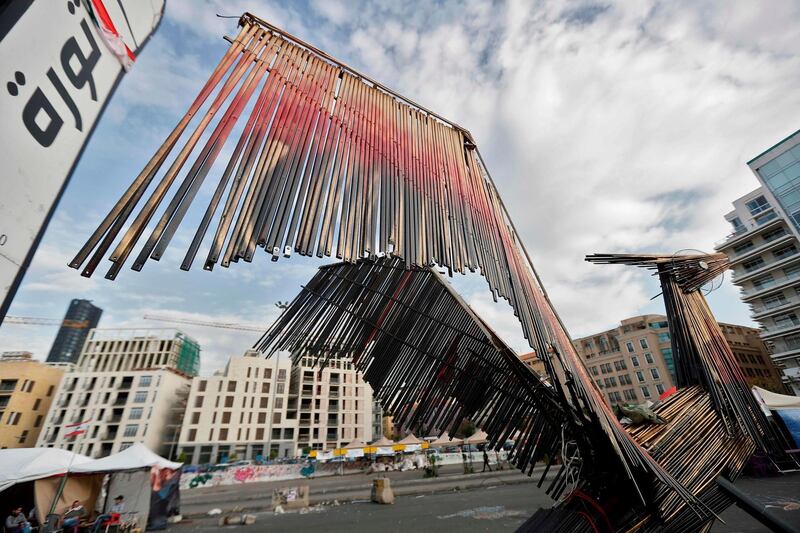First, there were the martyrs. Then, the phoenix. Then, the revolutionary woman. In the past two weeks, the famed bronze statue in Beirut's Martyrs' Square that was built in honour of Lebanese nationalists executed by the Ottomans in 1916 has been joined by two neighbours – two sculptures that are decades younger than the civil war-scarred statue, but which are arguably just as powerfully symbolic.
One of the new sculptures, a giant phoenix, positioned as if about to take flight, was pieced together by anti-government protesters out of the remains of protest tents destroyed by government supporters. "It was really a collaboration of all Lebanese people – of all religions, all sects, all areas," says Hayat Nazer, the Beirut-based artist who had the idea for the piece. "There were even old men with white hair working on it. And there were several who had blood coming out of their hands because the metal pieces (from the tent frames) were broken and had sharp, ragged edges."

Nazer, who had originally gone down to the protest site, just south of Martyrs' Square, on Lebanese Independence Day to build the phoenix alone and was quickly joined by a hundred people wanting to help, says she begged the men with bleeding hands to stop. "But they would not," she says. "They were like, 'No, no, we have to finish. This phoenix has to rise.'" And within only a few hours, rise, it did.
Work continued on the sculpture for a few more days, though, with engineers and architects offering their technical knowledge, another person donating LED lighting to give the creature fiery eyes and blazing feathers at night and one man even voluntarily waking up before dawn every morning to go and check that nothing had happened to the sculpture overnight – and then messaging Nazer with an update.
Such determination seems representative of the very message that Nazer was trying to convey in the first place. As the artist, 32, explains, she had wanted to build the phoenix – a mythical bird that is born again from the ashes of its predecessor – to show that "we [the Lebanese people] will not burn, we will not break, we will be victorious".
"While the idea of the phoenix on its own is very strong, and it coming from the burnt tents is very strong, for me, what's even stronger is that, on the day of independence, the Lebanese people built it", says Nazer, sitting in the protest site at night, raising her voice to be heard above the revolutionary songs being blasted out from a speaker as passers-by stop at regular intervals to take photos of the bird.

The second new sculpture to appear in this part of downtown Beirut in recent days is also as powerful. Titled Revolution is a Woman, the figure of a woman waving a Lebanese flag is made out of rubbish collected from the protest sites in the area, including water bottles, cans and even the plastic tips used to smoke shisha – a common activity for many of those protesting.
Pierre Abboud, 47, the Dubai artist and interior designer behind the work, says he was inspired to fly back to his home country to build it after witnessing the strength of the Lebanese women who have taken part in the countrywide protests since October 17, including the wife of Alaa Abou Fakhr, the protester killed by a soldier in front of his family last month. "When this young man was shot and his wife was kissing his hand [at the funeral], I was really touched by the scene and I did a drawing. And then I saw all the women on the street trying to make peace between the men," he says, referring to the female protesters who have deliberately stood between their male counterparts, the security forces and government supporters to prevent bloodshed (one of whom, incidentally, has been Nazer, the artist behind the phoenix).

"The women are still keeping this revolution very moderate, very decent, very creative … I want to tell the women, thank you – to my mother, to my sister, to my wife. The women are keeping it peaceful, while they [the politicians] want to make it bloody."
The recycled materials from which Abboud's revolutionary woman is made of, meanwhile, are a nod to another central theme of the recent Lebanese protests: recycling and the environment. With the country long having grappled with waste crises, protesters have made it a point to clean up after themselves and to recycle as much rubbish as they can from the protest sites, including in downtown Beirut where Abboud sourced his sculpture's materials from a specially designated recycling site.
"The trash that we have is gold," says Abboud, who describes "trash art" as his passion and who was involved in a record-breaking effort in Lebanon last year to create the world's largest recyclable material mosaic.
“Let’s think ‘environment’ through the whole country. Let’s make use of the trash. Let’s be creative and arrange our environment versus art … Lebanon should be the country of beauty and art. And the sculpture is a small message to show how we can do that – using the trash, using the bad things.”
Though Abboud's sculpture was designed and financed by him, however, like the phoenix, it is the work of many people. The artist employed the help of many friends, contacts and colleagues. And when Abboud and his team were working on the sculpture at the protest site, as Nazer also experienced, passers-by kept offering to help. "People were amazing … There is a vibe I never saw. They helped me all day long."
Abboud, who moved to the UAE in 2005 after finding that he kept running into obstacles with the authorities in Lebanon as a young artist, added that he had never before dreamed of being able to put a sculpture in a square in Beirut.
"And today, I don't own it anymore," he says. "It's for the streets."











